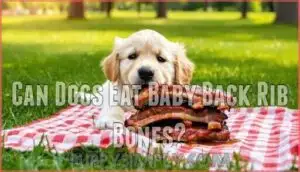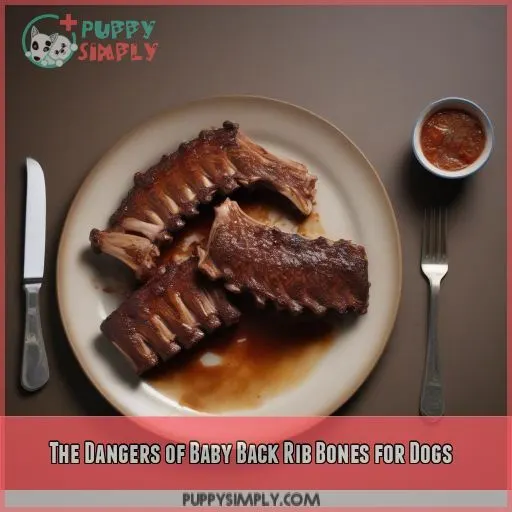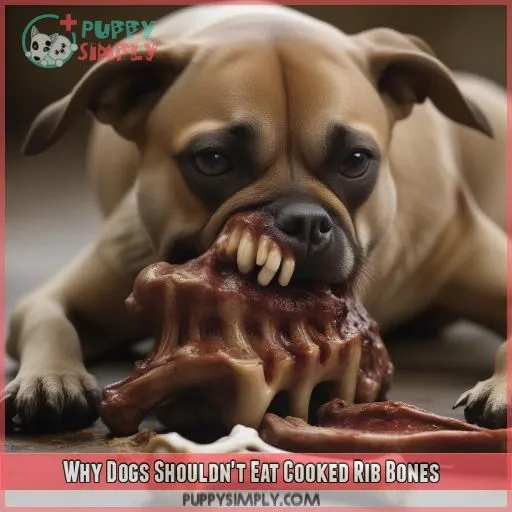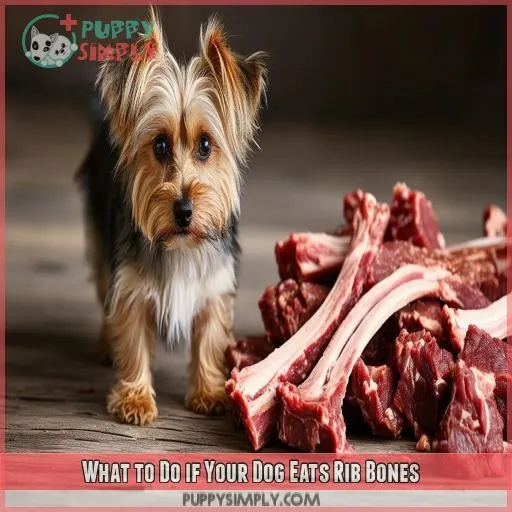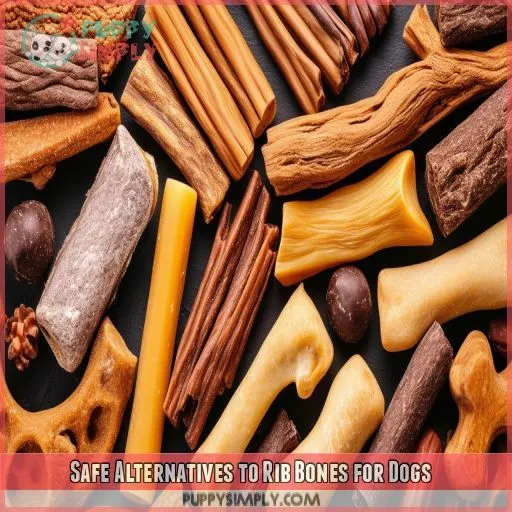This site is supported by our readers. We may earn a commission, at no cost to you, if you purchase through links.
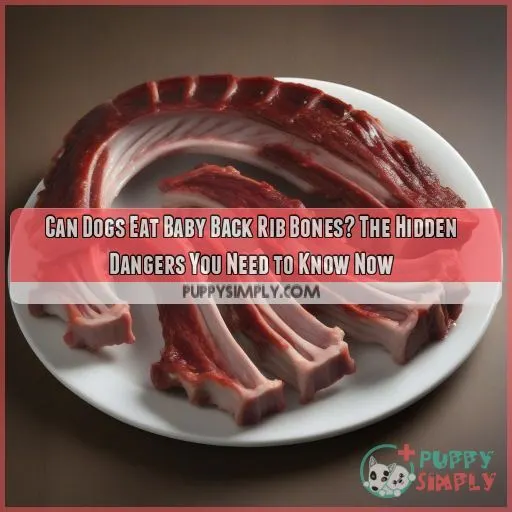
The hidden dangers are serious: choking hazards, intestinal damage, and bacterial contamination. Cooked bones especially can splinter, leading to potential obstructions and dental harm.
Before letting your dog indulge, learn the risks and safer alternatives. Your pet’s health and safety depend on making informed decisions about what they chew
Table Of Contents
- Key Takeaways
- Can Dogs Eat Baby Back Rib Bones?
- The Dangers of Baby Back Rib Bones for Dogs
- Why Dogs Shouldn’t Eat Cooked Rib Bones
- What to Do if Your Dog Eats Rib Bones
- Safe Alternatives to Rib Bones for Dogs
- Preventing Dogs From Accessing Rib Bones
- Frequently Asked Questions (FAQs)
- What happens if dogs eat baby back ribs bones?
- What bones are safe for dogs to eat?
- Can a dog’s stomach dissolve a bone?
- What if my dog eats a cooked bone?
- Can dogs eat baby back rib bones?
- Can dogs eat pork ribs?
- Are rib bones safe for dogs?
- Can dogs eat short rib bones?
- Can I Give My Dog Rib Bones?
- Can baby back rib bones be toxic to dogs?
- Are baby back rib bones nutritious for dogs?
- How to prepare dog-specific bone treats safely?
- Can puppy teeth handle rib bones safely?
- What makes rib meat safer than rib bones?
- Conclusion
Key Takeaways
Chewing on baby back rib bones is a surefire way to give your furry friend a bone to pick with you!
These bones can splinter and cause a world of hurt, from choking to intestinal damage.
Instead, reach for safer alternatives like chew toys that won’t turn into a trip to the vet
Can Dogs Eat Baby Back Rib Bones?
Dogs shouldn’t eat baby back rib bones due to significant risks involved. These bones can easily splinter, posing choking hazards and potentially causing serious internal damage like intestinal perforation and bowel obstruction.
Even cooked rib bones aren’t safe as they can break into sharp fragments. There’s also the risk of bacterial contamination.
If your dog manages to grab one, watch closely for symptoms like vomiting or lethargy and contact your vet immediately.
Instead, offer safe alternatives like durable chew toys or digestible treats.
Want to keep your furry friend out of trouble? Stick around to learn the essential steps
The Dangers of Baby Back Rib Bones for Dogs
You might think baby back rib bones are a tasty treat for your dog, but they can pose serious dangers. These bones can cause choking, damage your pet’s intestines, and even lead to bacterial infections if contaminated
Choking Hazards
You probably throw your dog a rib bone and think it’s no big deal. That’s pretty dangerous.
Cooking causes the bones to splinter, which then may create sharp fragments your dog could swallow and potentially get stuck in their throat. These foreign bodies may lead to choking, turning that good treat into a hazardous situation.
Keeping your furry friend safe means making alternative chews for your buddy and paying attention to bone disposal
Intestinal Damage
Beyond choking, rib bones pose serious risks to your dog’s gastrointestinal tract. These sharp fragments can cause intestinal perforation, leading to life-threatening peritonitis.
Cooked rib meat may seem harmless, but the bones can splinter, causing gastrointestinal bleeding or bowel obstruction. Even if they pass through, they can irritate the digestive system, potentially triggering pancreatitis.
Don’t gamble with your pup’s health – the risks of feeding dog bones far outweigh any perceived benefits
Bacterial Contamination
You may think that raw bones are safe, but they’re a breeding ground for bacteria. Whether raw or cooked, the rib bones can harbor dangerous pathogens that can make your poor dog quite sick with gastrointestinal upset. So don’t be swayed by arguments that dogs benefit nutritionally from them; the risks always outweigh any benefits. Here’s what you need to know:
- Raw bones, by their nature, pose a higher Salmonella risk
- Cooked bones aren’t immune to bacterial contamination
- Supervision is very important if you do decide to give bones
Always ask about safe chewing alternatives with your vet.
Why Dogs Shouldn’t Eat Cooked Rib Bones
Cooked rib bones pose serious risks to your dog’s health due to their tendency to splinter and cause obstructions. These hardened bones can also damage your pet’s teeth, potentially leading to costly dental procedures and pain for your furry friend
Increased Risk of Splintering
You know the risks of the baby back rib bones. However, there’s more.
Any cooking you perform on your rib bones will make them brittle. The risk of them splintering runs much higher than their raw counterparts. Sharp fragments can result in broken teeth, mouth lacerations, and gastrointestinal complications.
Raw bones are much softer, but they aren’t free from risks, either.
All methods of keeping your fur baby safe pertain to strict feeding guidelines and alternative chew options. Prevention methods will be vital to keeping these potential dangers at bay
Potential for Obstruction
Beyond splintering, cooked rib bones pose a serious obstruction risk. Your dog’s digestive system isn’t equipped to handle these dense fragments. Here’s what you need to know:
- Bone size matters – larger pieces can block the esophagus
- Soft tissue damage may occur in the stomach or intestines
- Nutritional value is lost when cooking pork
- Protein loss makes baby back ribs less beneficial
- Obstruction can lead to emergency surgery
Don’t gamble with your pup’s health. Always seek medical advice if you suspect bone ingestion
Dental Damage
Beyond obstructions, cooked rib bones pose a serious threat to your dog’s dental health. The hardness of these bones can lead to broken teeth, especially in enthusiastic chewers like Labrador Retrievers.
Damaged teeth aren’t just painful; they can result in decay, infection, and jaw damage. Plus, bone fragments stuck between teeth cause bad breath.
Instead of risking dental damage, opt for safer alternatives like bully sticks or durable rubber toys
What to Do if Your Dog Eats Rib Bones
If your dog has eaten rib bones, monitor for vomiting or other signs of discomfort, such as lethargy or constipation. Contact your veterinarian immediately if you notice any concerning symptoms or whether he seems to be in pain.
Monitoring for Symptoms
If your dog’s eaten rib bones, you’re not out of the woods yet. Keep a close eye on them for potential issues in their gastrointestinal tract. Here’s what to watch for:
- Vomiting or retching
- Difficulty passing stool
- Lethargy or loss of appetite
- Abnormal behavior or discomfort
Don’t wait for bone fragments to cause dental damage. Consider safer alternatives like digestive treats instead of buffalo chicken wings. Remember, your pup’s health trumps the convenience of tossing bones in the garbage can
When to Contact a Veterinarian
If your dog has shown no signs and symptoms within 48 hours, you’re probably in the clear. However, don’t let down your guard.
Do watch for vomiting, lethargy, or changes in appetite. If these crop up, it’s time to call in the vet.
The situation will be assessed, and an X-ray, among other tests, may be recommended. Keep in mind that early intervention might just be a lifesaver.
Always err on the side of caution when it comes to health matters concerning your furry friend
Emergency Procedures
If you’ve contacted your vet and they recommend immediate action, follow their emergency procedures. They might suggest inducing vomiting or rushing your dog in for surgical intervention.
Don’t attempt home treatment without professional guidance.
During the observation period, keep a close eye on your pup’s behavior and stool
Safe Alternatives to Rib Bones for Dogs
Instead of risking your dog’s health with rib bones, offer safe alternatives that satisfy their chewing instincts. Provide appropriate chew toys, digestible treats, and engage in supervised chewing activities to keep your furry friend happy and healthy
Appropriate Chew Toys
Instead of hazardous rib bones, let’s explore some safer chew options for your best friend. Keep in mind the chewing habits and preferences of your dog when you make a decision.
Durable rubber toys, like Kongs, are much more resistant to heavy chewing and are fantastic for dental hygiene. Good choices also include nylon bones and rope toys.
The toy should be larger than your dog’s mouth, and during chew time, the pup must always be kept under close supervision for his safety
Digestible Treats
While chew toys are great, digestible treats offer another safe alternative to rib bones.
You’ll want to focus on chew safety when selecting snacks for your pup. Look for alternative treats specifically designed for dogs’ chewing habits and digestive health.
Dental chews, bully sticks, and freeze-dried meat treats are excellent options. These safe snacks satisfy your dog’s urge to chew while providing nutritional benefits, keeping them happy and healthy
Supervised Chewing Activities
Watch for chewing. Avoid hazardous things, consider safety factors, and opt for bully sticks or extra-tough rubber toys. Make sure to watch your dog while chewing in case of any unsafe behavior. Monitoring them, mainly with new toys cleaned from which they might swallow big pieces, is very important. Keep them safe by choosing wisely and being vigilant!
Preventing Dogs From Accessing Rib Bones
To prevent dogs from accessing rib bones, make sure to properly dispose of bones in sealed garbage containers that are out of reach. Training and creating a safe eating environment are also critical to keeping your dog safe from harmful bones
Proper Disposal Methods
One has to ensure proper disposal of the rib bones for the safety of pets. Use these methods to make sure safe disposal:
- Wrap bones tightly before disposing of them in the trash.
- Secure waste containers with tight-fitting lids.
Store garbage outside or in a pet-proof area.
- Take out the garbage on time after meals.
- Supervise your dog around trash cans.
Effective waste management reduces the risks from bone fragments and ensures a safer surrounding.
Training and Behavioral Management
Consider training methods and positive reinforcement to protect your dog from rib bones. Add the commands "leave it" and "drop it" with treats or other chew options. Crate training while you’re away and redirecting the behavior at all times to safe chew toys will help minimize the risk associated with the ingestion of dangerous rib bones by your dog.
Creating a Safe Eating Environment
Creating a safe eating environment is essential for pet safety. Dispose of rib bones securely to prevent your dog from accessing them. Use sealed trash bins out of reach. Train your dog to avoid trash and food scraps. Offer safe chewing options, like tough rubber toys or healthy treats, to satisfy their natural chewing instinct and promote proper dog nutrition
Frequently Asked Questions (FAQs)
What happens if dogs eat baby back ribs bones?
If your dog eats baby back rib bones, they can choke, suffer mouth or throat injuries, or experience intestinal blockages and lacerations. Monitor them for vomiting, diarrhea, or distress, and contact a veterinarian immediately if symptoms occur
What bones are safe for dogs to eat?
Safe bones for dogs include large, raw beef or bison bones and commercially sold alternatives like bully sticks, antlers, and tough rubber toys. Always supervise your dog while chewing to avoid potential hazards
Can a dog’s stomach dissolve a bone?
A dog’s stomach can’t fully dissolve a bone. Instead, bones can splinter and pose serious risks, such as choking, intestinal blockages, and injuries to internal organs. Always opt for safer chewing alternatives to protect your pet
What if my dog eats a cooked bone?
If your dog eats a cooked bone, there’s a 35% chance of complications like choking or intestinal blockages. Monitor your dog closely, watch for distress signs, and contact your vet immediately if symptoms appear
Can dogs eat baby back rib bones?
No, dogs shouldn’t eat baby back rib bones. They can splinter, cause choking, damage their mouth, throat, or intestines, and lead to serious health issues. Always opt for safer chewing alternatives like bully sticks or tough rubber toys
Can dogs eat pork ribs?
No, you shouldn’t give pork ribs to your dog. These bones can splinter, causing choking, mouth injuries, or internal damage. They also risk bacterial contamination. Stick to safer alternatives like bully sticks or tough rubber toys
Are rib bones safe for dogs?
Is feeding dogs rib bones a good idea? Absolutely not. Rib bones can splinter, causing choking or intestinal damage. They also might be contaminated with bacteria. Stick to safer alternatives like bully sticks or durable rubber toys
Can dogs eat short rib bones?
Dogs shouldn’t be fed short rib bones as they may splinter down the throat, into the digestive tract, or pierce their way through these organs. Offer safe alternative chew items instead, such as bully sticks or hard rubber toys. Always be present with your dog while they’re chewing on something to make sure that they’re safe.
Can I Give My Dog Rib Bones?
As for the bones, particularly the ones from the ribs, it’s best to avoid them since they can splinter. This means they may cause severe harm by either choking or damaging the intestines. Keep safe, attractive options handy instead, and always put your dog’s safety and welfare first.
Can baby back rib bones be toxic to dogs?
Baby back rib bones aren’t safe for dogs. They can splinter, causing choking or internal injuries. They might also be contaminated with harmful bacteria. Instead, give your dog safe chewable toys like bully sticks or tough rubber toys
Are baby back rib bones nutritious for dogs?
Baby back rib bones aren’t nutritious for dogs. They can splinter and pose serious health risks, including choking, mouth injuries, and intestinal blockages. Choose safer chew options like bully sticks, antlers, or tough rubber toys
How to prepare dog-specific bone treats safely?
Skip the bone madness! For safe dog bone treats, choose large, tough rubber toys or bully sticks. Supervise your dog while chewing to prevent any mishaps. Always opt for alternatives that won’t turn into a trip to the vet
Can puppy teeth handle rib bones safely?
Puppy teeth can’t handle rib bones safely. The risk of splintering, choking, or causing internal damage is too high. Instead, offer safer chew alternatives like tough rubber toys or bully sticks, and always supervise your puppy
What makes rib meat safer than rib bones?
Rib meat won’t splinter and harm your dog’s insides like rib bones. Think of rib meat as the hero, offering nutrition without the treacherous risks. Always choose boneless for your dog’s safety and health
Conclusion
Allowing your dog to chew on baby back rib bones can be a recipe for disaster. The risks of choking, intestinal damage, bacterial contamination, and splintering far outweigh any potential benefits.
You should opt for safer alternatives like appropriate chew toys and digestible treats. Always monitor your dog’s chewing habits, and dispose of rib bones properly. Your pet’s health depends on it.

